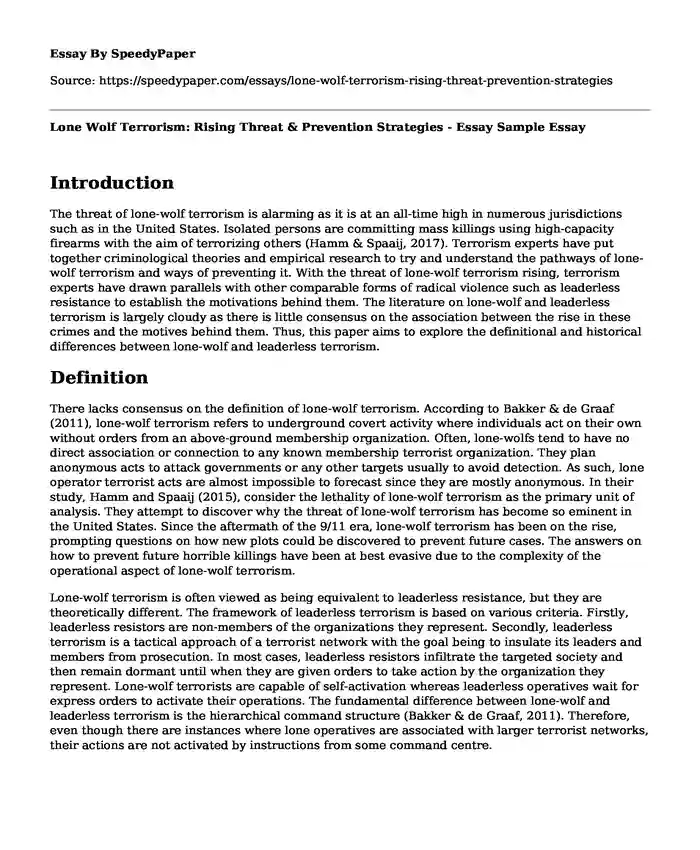
| Type of paper: | Essay |
| Categories: | Terrorism |
| Pages: | 3 |
| Wordcount: | 657 words |
Introduction
The threat of lone-wolf terrorism is alarming as it is at an all-time high in numerous jurisdictions such as in the United States. Isolated persons are committing mass killings using high-capacity firearms with the aim of terrorizing others (Hamm & Spaaij, 2017). Terrorism experts have put together criminological theories and empirical research to try and understand the pathways of lone-wolf terrorism and ways of preventing it. With the threat of lone-wolf terrorism rising, terrorism experts have drawn parallels with other comparable forms of radical violence such as leaderless resistance to establish the motivations behind them. The literature on lone-wolf and leaderless terrorism is largely cloudy as there is little consensus on the association between the rise in these crimes and the motives behind them. Thus, this paper aims to explore the definitional and historical differences between lone-wolf and leaderless terrorism.
Definition
There lacks consensus on the definition of lone-wolf terrorism. According to Bakker & de Graaf (2011), lone-wolf terrorism refers to underground covert activity where individuals act on their own without orders from an above-ground membership organization. Often, lone-wolfs tend to have no direct association or connection to any known membership terrorist organization. They plan anonymous acts to attack governments or any other targets usually to avoid detection. As such, lone operator terrorist acts are almost impossible to forecast since they are mostly anonymous. In their study, Hamm and Spaaij (2015), consider the lethality of lone-wolf terrorism as the primary unit of analysis. They attempt to discover why the threat of lone-wolf terrorism has become so eminent in the United States. Since the aftermath of the 9/11 era, lone-wolf terrorism has been on the rise, prompting questions on how new plots could be discovered to prevent future cases. The answers on how to prevent future horrible killings have been at best evasive due to the complexity of the operational aspect of lone-wolf terrorism.
Lone-wolf terrorism is often viewed as being equivalent to leaderless resistance, but they are theoretically different. The framework of leaderless terrorism is based on various criteria. Firstly, leaderless resistors are non-members of the organizations they represent. Secondly, leaderless terrorism is a tactical approach of a terrorist network with the goal being to insulate its leaders and members from prosecution. In most cases, leaderless resistors infiltrate the targeted society and then remain dormant until when they are given orders to take action by the organization they represent. Lone-wolf terrorists are capable of self-activation whereas leaderless operatives wait for express orders to activate their operations. The fundamental difference between lone-wolf and leaderless terrorism is the hierarchical command structure (Bakker & de Graaf, 2011). Therefore, even though there are instances where lone operatives are associated with larger terrorist networks, their actions are not activated by instructions from some command centre.
Conclusion
In summary, the dangers of lone-wolf terrorism are critical concerns for counter-terrorism operations. Terrorism experts have sought to understand the theoretical framework of lone-wolf terrorism to enable the development of counter-terrorism approaches. However, the pathway of lone-wolf radicalization is complex as lone wolfs rarely ascribe to any terrorism network. Although they may seek online sympathizers or be inspired by a particular organization, they are not bound by orders from any person or network. There is no established single profile for a lone operative, and this makes forecasting their activities difficult. In comparison, leaderless terrorists are different from lone-wolf operatives since the latter receive orders from a specific command structure in order to activate their terrorist acts.
References
Bakker, E. & de Graaf, B. (2011). Preventing lone-wolf terrorism: Some CT approaches addressed. (Links to an external site.) [4 pages]. Retrieved from http://www.terrorismanalysts.com/pt/index.php/pot/article/view/preventing-lone-wolf/html
Hamm, M. & Spaaij, R. (2015). Lone-wolf terrorism in America: Using knowledge of radicalization pathways to forge prevention strategies. https://www.ncjrs.gov/pdffiles1/nij/grants/248691.pdf
Hamm, M. S., & Spaaij, R. F. (2017). The American Lone Wolf Terrorist. mmIn The age of alone wolf terrorism (pp. 35-58). Columbia University Press.
Cite this page
Lone Wolf Terrorism: Rising Threat & Prevention Strategies - Essay Sample. (2023, Nov 14). Retrieved from https://speedypaper.net/essays/lone-wolf-terrorism-rising-threat-prevention-strategies
Request Removal
If you are the original author of this essay and no longer wish to have it published on the SpeedyPaper website, please click below to request its removal:
- Free Essay with a Discussion on Gender and Communication
- Race and Identity Essay Example
- Helping Victims of Human Trafficking - Paper Sample
- Free Essay. The Poor Communication Skills
- Role of Extroversion in Choice of Roommate - Essay Sample
- Essay on Protectionism: Advantages & Disadvantages of Tariffs
- Paper Sample on Social Psychology: Personality, Emotion, and Motivation
Popular categories




